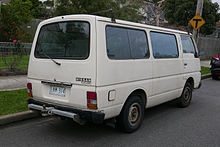Nissan Caravan
| Nissan Caravan | |
|---|---|
 | |
| Overview | |
| Manufacturer | Nissan Nissan Shatai |
| Also called | Nissan Urvan Nissan King Van Isuzu Como |
| Production | 1973–present (Nissan Caravan) 1965–1997 (Nissan Homy) |
| Body and chassis | |
| Layout | FR layout |
| Related | Nissan Homy |
The Nissan Caravan is a van designed by Nissan for use as a fleet vehicle or cargo van since 1973. Between 1976 and 1997, a rebadged version of the Caravan sold as the Nissan Homy, which was introduced as an independent model in 1965. Outside Japan, the Caravan was sold as either Nissan Urvan, Nissan King Van, or Nissan Homy.
Prior to 1973, the Caravan's twin, the Homy had been offered as a standalone generation from 1965 until 1976. The Homy was built and sold by the Prince Motor Company before the merger of Nissan in 1965 and the Homy was the first vehicle to be acquired by Nissan. After the merger in August 1966, the Prince Homy name was changed to Nissan. The merger was complete by 1970. It shared a chassis with the Prince Homer, a small pickup truck. The second generation Homy of 1976, was marketed as a twin to the 1973-era Nissan Caravan, sold at the Nissan Prince dealerships. The first generation series B640 which was changed to Nissan series T20 was built from 1965 to 1976, the second generation E20 was built from 1976 to 1980, and the third generation E23 was built from 1980 to 1986. The final generation E24 was built from 1986 to 1999, and replaced by the Nissan Elgrand. Mechanically, the Nissan Caravan and the Nissan Homy were identical. Its traditional competitor from Toyota is the Hiace.
In the Philippines, the Nissan Caravan E26 will arrive on June 11, 2015 and will be known as NV350 Urvan. The new Urvan will come from Japan instead of being assembled locally.
B640 (1965–1976)

The Prince Homy (B640) had a seating capacity of up to 15 people. In 1966 as the Prince-Nissan merger began, it was initially called the Nissan Homy Prince, and the Prince name disappeared in 1970. The Nissan Homy received the T20 model code. In 1972, the vehicle was reclassified as a commercial vehicle, in order to comply with the 1970 Japanese Road Traffic Law. Nissan didn't have a companion vehicle for the Homy, so from 1973 the Homy was also available rebadged as the Nissan Caravan.
E20, E21, E22 (1973–1980)
| First generation (E20) | |
|---|---|
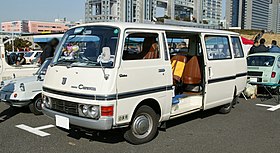 | |
| Overview | |
| Also called | Datsun Urvan Nissan Homy |
| Production | 1973–1980 |
| Body and chassis | |
| Body style | 3-door van 4-door van |
| Powertrain | |
| Engine | |
| Dimensions | |
| Wheelbase |
|

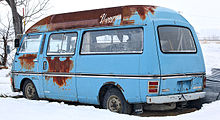
The Caravan/Urvan is a van and minibus manufactured from February 1973 by Nissan with 3, 5, 7, and up to 10 seats. It was exclusive in Japan to Nissan Bluebird Store, while its twin the Nissan Homy was exclusive to Nissan Prince Store locations. It was especially popular in Europe, and was again very popular with Fire Departments and as ambulances in certain countries. It had a somewhat difficult handling, as it was heavy to steer, and was not available with power steering. Also, the gear shifter was located at the floor and went all the way up to the height of the hand, and had a slight curve. The gear shifter was nearly 80 cm (2.6 ft) long, so it was somewhat clumsy to shift, but it came with five gears, unusual in Europe at that time. It was delivered with a 1.5 and a 2.0 litre petrol engine, as well as a 2.2 litre diesel unit. It was produced until replaced by the E23 Caravan in late summer 1980.
In export markets the first and second generations were called Datsun Urvan, until the Nissan brand replaced it worldwide in 1983–1984.This generation is becoming rare and suffers from rust problems.
- Nissan Homy
The second generation was essentially a cosmetic update with no major mechanical changes. The model code changed to E20.
E23 (1980–1986)
| Second generation (E23) | |
|---|---|
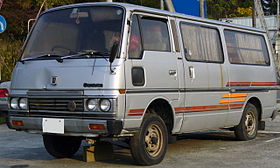 Nissan Caravan (E23) LWB | |
| Overview | |
| Also called | Datsun Caravan/Urvan (until 1983) Nissan Homy Nissan Urvan Yue Loong Homer 747 (ROC) |
| Production | 1980.08-1986 |
| Body and chassis | |
| Body style | 4-door van 5-door van/coach |
| Related | Nissan Atlas Nissan Cabstar Nissan Homy |
| Powertrain | |
| Engine | 1.6 L J16 OHV I4 1.8 L Z18S I4 2.0 L H20 OHV I4 2.0 L Z20S I4 2.0 L LD20T turbodiesel I4 2.2 L SD22 diesel I4 2.3 L SD23 diesel I4 |
The second generation Nissan Urvan/Caravan (E23) was introduced in August 1980.[1] As before, the Homy, sold through Prince dealerships, was its sister model, set apart by a different grille. The Cabstar and Homer shared much of the bodywork, with the main differences being the frontal treatment and a small side window mounted in the front doors of the Caravan/Homy. Engines were all carryover four-cylinders, ranging from the J16 and H20 pushrod items, via the overhead cam Z20S, and an upgraded SD22 diesel. The van versions were now designed to allow access to the loading area from the passenger compartment. Radial tires were optional. The diesel also benefitted from a new five-speed manual gearbox, while the new luxury GL version offered an optional "Nissanmatic" automatic transmission as well as power steering, comfortable rotating rear seats and air conditioning. In July 1981, a luxurious SGL "Silk Road" version was added.
At the 1981 Tokyo Motor Show, two concept Caravans designed to provide limousine-like accommodation for businessmen were shown, the Royal and Elgrand Royal Line. The Elgrand name was to be adopted for a series of luxurious minivans, beginning in 1997. In May 1982 the Caravan underwent a minor facelift, losing the ventilation window in the front doors, receiving a new dashboard and a new five-bearing SD23 diesel engine replacing the previous SD22.[1] Radial tires became standard for all but the cheapest versions. For more power, coach versions also became available with the turbocharged LD20T diesel. The luxurious "Silk Road" version, with seven captain seats, was only available with the LD20T. This engine passed the 1982 emissions standards for diesel cars. To meet the 1981 emissions standards for petrol cars, coach versions replaced the H20 engine with the new carburetted Z18S and 105 PS (77 kW) Z20S.
In April 1983 there was another light facelift, with SGL and GL versions receiving a new look with four square headlights.[1] An LWB DX ten-seater version was also added. In January 1985 six and nine-passenger van versions were added. Diesel versions received improved pre-heating systems and safety equipment was improved. Manual petrol versions were now all five-speed manuals. An eight-seater "SGL Silk Road Limited" also joined the lineup in May. In September 1986 the E23 was replaced by the third generation E24.[1] This generation like the generation before suffers from rust problems.
- Nissan Homy
The Homy and its Caravan twin received their first full model change since the Homy was introduced in 1965. The engine was the 2.0 litre inline-four SOHC LD20T turbodiesel. The TD23 inline-four was also available. In 1981, the Homy became a support vehicle for motorcades involving the Emperor of Japan.
E24 (1986–2015)
| Third generation (E24) | |
|---|---|
 | |
| Overview | |
| Also called | Nissan Homy Nissan Urvan Nissan Urvan Escapade Nissan Urvan Shuttle Nissan Caravan Homy Isuzu Fargo |
| Production | 1986–present 2001-2015 (Philippines) |
| Assembly | Thika, Kenya Makati City, Philippines |
| Body and chassis | |
| Body style | 3-door van 4-door van |
| Powertrain | |
| Engine | 2.3 L TD23 diesel I4 2.5 TD25 diesel I4 2.7 L TD27 diesel I4 2.7 L TD27T1 turbodiesel I4 3.2 L QD32 diesel I4 2.4 KA24DE Petrol I4 3.0 L VG30E Petrol |
The E24 version was built from 1986 until 2001 and underwent two major facelifts. In some Scandinavian markets, the E24 series was marketed as the "King Van", to tie it in with the popular "King Cab" version of Nissan's D21 pickup truck. The large QD32 four-cylinder diesel was added in 1996 and produced 100 PS (74 kW) from 3,153 cc.
In Kenya, the Nissan E24 is still manufactured by the Kenya Vehicle Manufacturers in Thika.[2]
Nissan Homy
The Homy received its second full model change in September 1986 and was given a 2.0 L Z20, as well as the LD20T turbodiesel. The model code was now E24. In October 1987 four-wheel drive was added to the 2.7 L TD27 engine. March 1988, the premium grade "GT Limousine" was offered with a VG30E alongside the 2.7 L turbodiesel. Yearly grade changes continued for the rest of the generation, adding items like cruise control, digital speedometers, larger wheels, upgraded interior and upholstery. August 1995 saw the Homy rebadged and sold as the Isuzu Fargo, using the TD27ETi diesel engine.
The Homy was replaced by the Nissan Elgrand in 1997.
-
E24 Caravan (middle version)
-
E24 Caravan Wagon (late version)
-
Nissan Homy (E24)
Nissan Urvan E24 (Philippines)
The Nissan Urvan in the Philippines was manufactured in Makati City from 2001 to 2014. They offered 3 variants: First is the 18 seater VX, commonly used as UV Express a transportation in the Philippines and School Service. Second is the 15 seater Shuttle, Also used as UV Express, Rental Van, Company service, and Media Van. Third is the 12-seater Escapade, The High End Model of E24 in the Philippine Market. All of these variants are equipped with 5-Speed Manual Transmission and 2.7 TD27T1 Turbo diesel engine.
E25 (2001–2012)
| Fourth generation (E25) | |
|---|---|
 | |
| Overview | |
| Also called | Nissan Urvan Nissan Urvan Estate Isuzu Como |
| Production | 2001–2012 |
| Assembly | Kanagawa, Japan Zhongji Company, Luanda, Angola[3] Makati City, Philippines Kuala Lumpur, Malaysia (TCMA) |
| Body and chassis | |
| Body style | 3-door van 4-door van |
| Powertrain | |
| Engine | 2.0 L I4 2.4 L I4 2.5 L I4 3.0 L diesel I4 |
| Transmission | 5-speed manual 4-speed Automatic Transmission |
| Dimensions | |
| Wheelbase | 2,715 mm (106.9 in) |
| Length | Pre-Facelift: 4,990 mm (196.5 in) Facelift: 4,995 mm (196.7 in) |
| Width | 1,690 mm (66.5 in) & 1,990 mm (78.3 in) |
| Height | 1,990 mm (78.3 in) & 2,285 mm (90.0 in) |
| Chronology | |
| Successor | Nissan NV (Mexico) Nissan NV350 Caravan (Japan) |
Produced from April 2001 to 2012. For Mexico, the only North American country for full-size Nissan vans, 2010 will be the last year for this generation, as the American-built Nissan NV replaces it, sharing a chassis with the Nissan Titan.[4] It was also sold as the Isuzu Como on the Japanese market, replacing the last generation Isuzu Fargo which was a rebadged version of the E24 Caravan. The New Zealand Urvan received a one-star rating on the ANCAP crash test.[5]
-
Nissan Urvan (Malaysia)
-
Nissan Urvan (Mexico)
-
Nissan Caravan GX (E25, late model)
-
Isuzu Como (E25)
NV350 (2012–present)
| Nissan NV350 Caravan (E26) | |
|---|---|
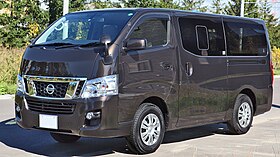 | |
| Overview | |
| Also called | Nissan NV350 Urvan Isuzu Como Mitsubishi Fuso Canter Van |
| Production | 2012–present |
| Assembly | Kanda, Fukuoka, Kyushu, Japan (Nissan Shatai) |
| Body and chassis | |
| Body style | 4-door van |
| Powertrain | |
| Engine | 2.5L YD25DDTi engine 2.0L QR20DE engine 2.5L QR25DE engine |
| Transmission | 5-speed Automatic 5-speed Manual |
| Dimensions | |
| Wheelbase | Van/Wagon Long Body:2,555 mm (100.6 in) Van/Wagon Super Long Body:2,940 mm (115.7 in) |
| Length | Van/Wagon Long Body:4,695 mm (184.8 in) Van/Wagon Super Long Body:5,080 mm (200.0 in) |
| Width | 1,695 mm (66.7 in) |
| Height | Van/Wagon Long Body:1,990 mm (78.3 in) Van/Wagon Super Long Body:2,285 mm (90.0 in)(High Roof) |
At the 2011 Tokyo Motor Show, a replacement of the Nissan Caravan, called the NV350 Caravan was premiered. It went on sale this June 15, 2012 with diesel engine and super long body variants will be on sale beginning July 13, 2012, and the wide version model is planned for winter 2012. The new NV350 Caravan comes with the all new YD25DDTi engine with clean diesel technology that achieves the class-leading fuel economy of 12.2 km per litre based on Japan's JC08 mode test cycle. Most petrol engines take advantage of its fuel saving technology for class leading fuel economy – QR20DE engine with 9.9 km per litre and QR25DE with 9.1 km – calculated based on JC08 mode. Those engines achieved either a 10% or 5% improvement in fuel economy over Japan's 2015 fuel economy standard. The NV350 Caravan continues to be sold as the Isuzu Como on the Japanese market as well. [6]
Production
In 2013-09-11, Mitsubishi Fuso Truck and Bus Corporation and Nissan Motor Co., Ltd reached a basic agreement regarding original equipment manufacturer supply of finished commercial vans for export, where Nissan would supply NV350 Urvan to Mitsubishi Fuso.[7][8]
E26 gallery
References
- ^ a b c d Car Graphic: Car Archives Vol. 11, '80s Japanese Cars (in Japanese). Tokyo: Nigensha. 2007. p. 141. ISBN 978-4-544-91018-6.
- ^ http://www.kvm.co.ke/
- ^ de:Zhengzhou Nissan Automobile Company German Wikipedia article about the Zhengzhou Nissan Automobile Co., Ltd.
- ^ 2011 Nissan NV1500 / NV2500 HD / NV3500 HD – Car News – Car & Driver Retrieved March 10, 2010
- ^ "Nissan Urvan (E25)". Australasian New Car Assessment Program. Retrieved 2014-06-02.
- ^ http://www.nissan-global.com/EN/NEWS/2012/_STORY/120615-01-e.html
- ^ Mitsubishi Fuso and Nissan Agree on Van OEM Supply for Export
- ^ 日産と三菱ふそう、OEM 供給で基本合意 ~商用バンの海外市場向け供給を検討~
External links
- Safety Recalls – Japanese Imports
- Official Nissan NV350 Site (Japanese)


